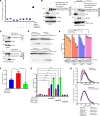Small molecules that disrupt RAD54-BLM interaction hamper tumor proliferation in colon cancer chemoresistance models
- PMID: 38421735
- PMCID: PMC11014671
- DOI: 10.1172/JCI161941
Small molecules that disrupt RAD54-BLM interaction hamper tumor proliferation in colon cancer chemoresistance models
Abstract
RAD54 and BLM helicase play pivotal roles during homologous recombination repair (HRR) to ensure genome maintenance. BLM amino acids (aa 181-212) interact with RAD54 and enhance its chromatin remodeling activity. Functionally, this interaction heightens HRR, leading to a decrease in residual DNA damage in colon cancer cells. This contributes to chemoresistance in colon cancer cells against cisplatin, camptothecin, and oxaliplatin, eventually promoting tumorigenesis in preclinical colon cancer mouse models. ChIP-Seq analysis and validation revealed increased BLM and RAD54 corecruitment on the MRP2 promoter in camptothecin-resistant colon cancer cells, leading to BLM-dependent enhancement of RAD54-mediated chromatin remodeling. We screened the Prestwick small-molecule library, with the intent to revert camptothecin- and oxaliplatin-induced chemoresistance by disrupting the RAD54-BLM interaction. Three FDA/European Medicines Agency-approved candidates were identified that could disrupt this interaction. These drugs bound to RAD54, altered its conformation, and abrogated RAD54-BLM-dependent chromatin remodeling on G5E4 and MRP2 arrays. Notably, the small molecules also reduced HRR efficiency in resistant lines, diminished anchorage-independent growth, and hampered the proliferation of tumors generated using camptothecin- and oxaliplatin-resistant colon cancer cells in both xenograft and syngeneic mouse models in BLM-dependent manner. Therefore, the 3 identified small molecules can serve as possible viable candidates for adjunct therapy in colon cancer treatment.
Keywords: Colorectal cancer; DNA repair; Oncology.
Figures






References
MeSH terms
Substances
LinkOut - more resources
Full Text Sources
